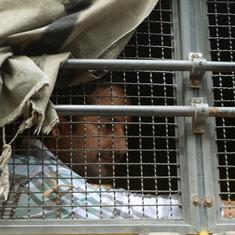Murder, though, is a slightly different kettle of fish. Killing another human being is one of the few universal taboos observed by all human cultures. But even here there is a gradation. Scores of murders take place every day but beyond the people directly affected, no one really cares.
The Sheena Bora case, though, comes at the intersection of a number of trends. It involves PLUs – people like us. The Agatha Christie principle of a scintillating murder: get a nice chap, one of our sorts to do it, and it’ll engender a particular kind of thrilling horror. And then, of course, this could be the most taboo form of murder: filicide; a mother killing her own child. Then there are massive financial dealings, allegations of lies (was Sheena, Indrani’s sister or daughter?) and even whispers of incest (she was both sister and daughter).
Fascinated reactions
As a result, people have had a grand time of getting scandalised with this case, bringing down the full weight of their shock and moralising to what has now become a full-blown tamasha. (No other word captures this as well; as Salman Rushdie once wrote, “The English lacks the thunderclap sound of the Urdu”).
This Indrani Mukherjee case is shocking beyond imagination! It will put the Arushi murderers in shame! pic.twitter.com/jRTaHSUogJ
— Arpita (@arpita_dg) August 27, 2015
So Indrani lied to husband Peter Mukherjee about not only her daughter but one of her earlier marriages too. Shocking!
— Bharti Jain (@toi_BhartiJ) August 26, 2015
Feeling sick in the stomach after reading Mikhail's interview in the TOI. Indrani sounds like an evil witch. #SheenaMurderMystery
— shunali shroff (@shunalishroff) August 27, 2015
Is Mukherjea couple's relationship the present & future of marriage as an institution among porn loving elites in India?
— Madhu Kishwar (@madhukishwar) August 27, 2015Others, while not so obviously voyeuristic, still pitched in, playing amateur detective on their 15-minute cigarette break on a Thursday (Twitter, it seems, is the new water cooler).
Chilling. Inside the car, Khanna caught hold of her hands, Rai held her legs, mom Indrani strangulated #SheenaBora http://t.co/70vec5vlio
— Abhijit Majumder (@abhijitmajumder) August 27, 2015WOAH! Indrani planned to kill Peter Mukerjea too! http://t.co/MNQkGXL2SA
— Berges (@berges) August 27, 2015Here is the diagrammatic explanation for you. Indrani's family tree. Dobara mat poochna.. pic.twitter.com/IDNrg6IRAb
— Saswat K Swain (@saswat28) August 27, 2015Of course, all that moderation was yanked out when another prurient revelation hit the airwaves
Shocking twists and turns in #SheenaMurderMystery. Srces say #IndraniMukherjea has reveald that Sheena was both her sister and daughter!!!!
— Kirandeep IBN7 (@raydeep) August 27, 2015*Head Spinning* ... *Head Spinning* .... *Head Spinning* ....*Head Spinning*......*Head Spinning*....*Head Spinning* https://t.co/PnxHtMVi26
— Pawan Durani (@PawanDurani) August 27, 2015Even this disclosure, though, once the shock had died down a bit, was subject to thorough logical scrutiny (or whatever the closest thing that Twitter has to that).
@raydeep matlab indrani slept wid her father . WTF
— kumar gaurav (@kanha89) August 27, 2015@raydeep that is impossible unless her father impregnated her, in which case she is daughter and sister since her father sired her.
— $ ₹ ! # € + x (@NyayaVrsa) August 27, 2015#SheenaBora case has reached such insane levels of complexity that it should now be handed over to @isro for further investigation. @raydeep
— Amit (@TimeToScoot) August 27, 2015The more cultured Tweeters though, immediately caught on to an art film link.
This Indrani Mukherjee case is turning out like that Chinatown movie -"She is my sister and my daughter, My father and I..."
— Ratnakar Sadasyula (@ScorpiusMaximus) August 26, 2015Media reportage
In all of this, the media had a staring role, playing up to the hilt a story that was almost too salacious to be true.
Like in the Aarushi Talwar case, the first thing the media did was to quickly make up its mind about who the killer was: Indrani Mukerjea. The Times of India had in fact, already gone a step further and was “nailing her lies”.

Even worse, India TV even held her guilty for being a – please don’t read further if you’re below 18 – “party lover and globetrotter”.
10 pics that shows #IndraniMukerjea is a party lover and globetrotter http://t.co/m9hqH4Pq9m pic.twitter.com/hiiqkJpdXx
— India TV (@indiatvnews) August 26, 2015What was driving this media reaction?
So the misogynistic media has now coined a new term for ambitious women - social climbers. Expect millions of articles using this term now.
— Bae-Gum (@LeftOverWoman) August 27, 2015Why pick on Radhe Maa for short skirt, #IndraniMukherjea for 3 husbands& ambition. Both women seem unsavoury. But at least get reasons right
— barkha dutt (@BDUTT) August 27, 2015And then, of course, there was the immense pressure of numbers; the desperation to attract eyeballs. Everyone did that to some extent but the first place for this endeavour, along with the runner up as well as third place, was won by this piece, which used the Bora murder to argue the rather bold proposition that there’s nothing wrong with a “brother and sister falling in love” (Before Cersie and Jamie Lannister "like" this, let me point out that the headline is misleading: the article speaks of cousin, not sibling love. Phew.)
How to cover a murder in the least sensitive way possible. Step 4; Thinkpiece party (WITH BONUS FESTIVAL CONNECT) pic.twitter.com/inKEJr3trr
— Rohan (@mojorojo) August 27, 2015At the other end of the scale from incest, the Bora murder also launched a discussion on the much more comfortably mundane topic of the irregular Roman orthography of Indian names.
@dhume Happens. The surname "Chakraborty" had the most alternative spellings in the Calcutta telephone directory. Some 35 variations
— Ashok Malik (@MalikAshok) August 27, 2015Suhel Seth, never one to be left behind on gossip of such massive propositions, jumped in with his own jaunty tale of the time he had tried to woo Indrani Mukerjea.
Last and least, there was the tiny minority who wanted to bring in law and ethics into this discussion and pull the plug on all the great fun everyone was having.
I know you guys are delirious with this crime thriller, but I implore you to study basic criminal law before reporting on crimes.
— अंशुल (@Ghair_Kanooni) August 27, 2015One more report shocked that elite/middle class might kill their children, & I will forcefeed last 10 yrs dowry death stats to the reporter.
— Nilanjana Roy (@nilanjanaroy) August 27, 2015Sheena Bora case, 'no DNA of deceased, nor proper remains of body. Police relying on co-accused only.' Careful, media. http://t.co/BRLGGjkUhm
— Karuna Nundy (@karunanundy) August 26, 2015









